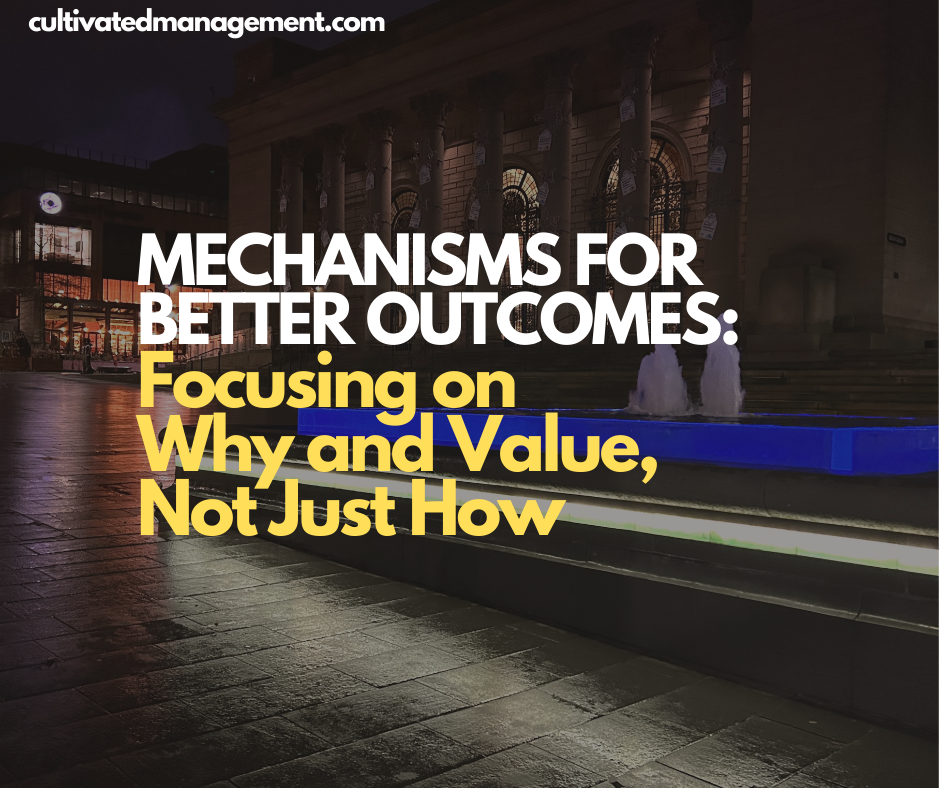
Mechanisms exist to support outcomes
I’ve worked with plenty (and I mean plenty) of people who are interested in the mechanics, or mechanisms, of a business.
This methodology, that one. This tool, that one. This approach, that one. This process, that one. This way of working, that one. This theory, that theory.
We all love mechanisms. We want to follow someone else's writing routine because they have 10 best selling books. We want to follow the specifics of an agile approach because someone said it worked for them. We want to follow the exact routine of a military specialist because they are ripped and healthy.
We love mechanisms. And we love them in work too. It's no surprise - we spend all day working in and with them.
However, mechanisms exist for outcomes. It’s the outcomes that are important.
This article first appeared in the Meeting Notes newsletter - Get One Idea a Week to Lead with clarity and cultivate workplaces that enrich the lives of all who work in them.
In the world of business those outcomes are of value to the business - and that is always external to the business (customers paying for stuff).
The mechanisms (ways of working, process, governance, metrics, approaches, rules etc) are inside the business - as such they are cost.
This is why I spend a lot of time as a consultant (and leader and manager) identifying clearly what the outcomes should be, rather than going in strong with my preferred mechanisms.
My time is often spent helping people to identify clear outcomes and to stop talking so much about the mechanisms.
Everyone likes mechanisms - they often occupy our minds and energy for days as we contemplate this one versus that, or we like this one over that one. But it is merely adding cost to the business (all cost is internal) if we're discussing them without a clear idea of what they are in support of (valuable outcomes).
Mechanisms exist to support outcomes - not the other way around.
But the trap here is that many people aren’t always sure what their outcomes are supposed to be - in other words - what are the business results?
And even fewer people can connect the dots between the work they do (tangible deliverables) and the value it releases to the business (always external to the business through customers paying for something).
And so, arguments, discussions, meetings, PowerPoints, more meetings, more discussions, more arguments, theories, brainstorming and more, ensues in the pursuit of the right mechanism, without fully knowing what the mechanism is actually in service of.
Opinions run high when it comes to mechanisms.
Don’t get me wrong, the mechanism is important, but not if we’re not sure about the outcomes (and the external value it leads to).
Every time we discuss a mechanism (like agile versus waterfall - and yes, that argument persists), we’re adding cost.
And so, my advice is to firstly work on deciding what the outcomes are, and then aim to tackle the mechanisms, technical problems and practical problems that need to be overcome, to achieve the outcomes.
After all, there is no point in discussing the mechanisms until we have made up our minds about what the outcomes are.
Only after deciding and knowing what we want, can we then be clear and settle on the right mechanisms.
Mechanisms always exist to support outcomes. Not the other way around. And many consultants themselves don’t see that either - and are more concerned with this way over that way, or this approach versus that, without spending the time to work out what the client wants - and what problems we therefore must solve (and then which mechanisms make the most sense for the context).
And in everyone’s day to day work life - it pays to be alert and attentive to how much time is spent discussing the mechanisms, at the expense of gaining clarity of outcomes.
Decide what the outcome is (ideally tracing the value that is external to the business), then discuss the mechanisms of overcoming the practical challenges that stand in the way. It’s highly likely you’ll settle on the most appropriate mechanisms once it’s clear what they are in service of and what problems they overcome.
A decision is also not a choice - clarity comes from closing down alternative options.
Decide, discuss mechanisms, move with clear and aligned action, refine the mechanisms as you learn more.
Sign up for Cultivated
Master the Art of Communication & Creativity. Cultivate a bright future of work.
No spam. Unsubscribe anytime.
